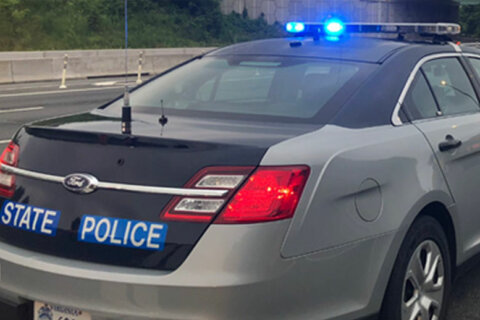This article was republished with permission from WTOP’s news partner InsideNoVa.com. Sign up for InsideNoVa.com’s free email subscription today.
This article was written by WTOP’s news partner InsideNoVa.com and republished with permission. Sign up for InsideNoVa.com’s free email subscription today.
Just as Prince William County Public Schools was recognizing “Mental Health Awareness Month” in May, a new report underscored a troubling rise in student misconduct in county schools.
A recent presentation to the school system’s Safe Schools Advisory Committee, obtained by InsideNoVa through a Freedom of Information Act request, shows a significant rise in student misconduct involving fighting and drugs, particularly among middle and high school students.
According to the report, which compares data from the first three quarters of the 2019-20 school year to the first three quarters of the current year, fight-related and alcohol/drug-related Code of Behavior violations increased by more than 20% during the current school year.
And the third quarter of the 2021-22 school year saw a significant spike in both kinds of violations compared with the first two quarters. In the third quarter alone, middle and high schools recorded 515 alcohol/drug-related violations, up from 344 in the second quarter of the 2021-22 year. (There was no alcohol/drug-related data for elementary schools.) The entire division recorded 722 fight-related violations, up from 463 in quarter two.
Those division totals also include reports from special programs and nontraditional schools. Of alcohol/drug-related violations, one of the biggest jumps was for using e-cigarettes. But even without those, the number of overall violations is still up dramatically from two years ago, despite the slight decline in in-person enrollment.
Accounts from across the country seem to indicate that school districts everywhere are dealing with increases in disruptive and problematic behavior. But many teachers within the county are raising an alarm that social issues in the aftermath of school closures, coupled with staffing shortages in schools, are making the job of educating students more difficult.
Nearly a dozen county teachers who have spoken with InsideNoVa over the past three months said that since the pandemic began they have encountered more classroom disruption and see a greater need for social, emotional and mental health resources.
And because of the nationwide teacher shortage that has left county schools less staffed than in previous years, the teachers say that additional need is harder to meet when they’re responsible for more students.
Teachers who agreed to speak to InsideNoVa asked to remain anonymous because of division policy that instructs teachers to clear any media requests with the division’s central office.
The fear among some is that the increased burden on teachers will only drive more from the profession, despite teacher pay increases like the over 7% raise in average salary for certified county school system staff next year.
“People are pretty exhausted, and these are people who mostly do this because they love teaching,” said one county high school teacher.
He told InsideNoVa that his school has seen an increase in drug use and fighting, both in the form of “small pushing and shoving” that typically doesn’t rise to the level of being reported and bigger fights that can leave kids hurt.
“Some kids are really dealing with a lot, and some were already dealing with a lot, but just regular classroom instruction comes with some more trouble than it did a couple of years ago. … Most kids still feel very safe, but seeing more students deal with drug issues is what has me most concerned, personally,” he said.
Compared with 2019-20, the number of code violations for “altercations” without injury has fallen this year, but the number of violations for “assault/battery” without “bodily injury” and “mutual party” fights with no or minor injuries has risen significantly.
When asked how much harder teaching is compared to before the pandemic, one middle school teacher told InsideNoVa, “On a scale from one to 10, probably an eight … I myself am going through this conversation internally about, do I stay or do I go?”
Aside from its efforts to hire more qualified teachers to fill vacancies, the division is also hoping to bring in more school counselors for the 2022-23 school year, with the fiscal 2023 budget funding more than 22 new full-time counselor positions across its 94 schools. The budget includes no new central office psychology positions.
If all 338 counselor positions were filled, there would be one counselor for about every 278 middle school students and every 300 high school students. That’s closer than in previous years to the 1:250 counselor-to-student ratio recommended by the American School Counselor Association, which Director of Student Services Rebekah Schlatter told InsideNoVa is the ultimate goal. But workforce shortages have also impacted the counselor ranks.
“It is not as bad as the teacher shortage, I can say that. But as we were seeing workforce shortages across the country in all areas, we did start to see a shortage in school counselor candidates,” Schlatter said. “So when I look back three years ago, we were in a great place. We had a lot of applicants for each of our positions … When we look at last school year and this school year especially … we did see fewer candidates than we have seen in the past.”
Counselors both proactively give classroom instruction to students and work with students who seek help on their own. For young students, Schlatter said, the classroom education often includes teaching kids about emotions and why they may feel different from day to day. As students get older, she said, much of the focus is on teaching students how to recognize when those emotions or feelings go from typical swings to something potentially more serious.
Counselors can also be called on to assist students who go through the school disciplinary process and are called on for “crisis response” when traumatic events for students take place, such as when two county teens died from apparent fentanyl overdoses in late April. But workforce shortages have also affected the school counselor ranks.
When asked about the advisory committee’s data, School Board Chair Babur Lateef said it tracked generally with what he’d heard from school staff. He said it will take years for students to recover from the disruption caused by the pandemic.
He added he has faith in the division’s educators – and Superintendent LaTanya McDade’s new budget and strategic plan – to eventually put the resources in place to help students recover.
“I don’t think we’re outside the national trend with what’s going on in schools … and I do believe it is a direct result of keeping kids home for so long,” Lateef said. “That has been a challenge, and getting everybody resocialized, reengaged and getting the learning recovered has been incredibly challenging. It will continue to be for both the short term and the long term. I mean, there is no quick fix for this.”
Schlatter said she thought there was enough personnel to adequately handle the current levels of need while saying that, naturally, schools could always use more. She also said that from her perspective, mental health and behavior issues among students hadn’t necessarily gotten worse.
“I think that the past couple years have really shined a light on a lot of different things. Is it necessarily worse than it has been?” Schlatter said. “Especially when you go back to pre-pandemic, I don’t think necessarily that statistically-speaking we are seeing things that are that much worse, per se. I think, as a society, we are paying more attention to what is happening, especially with our youth. We’re paying attention to their behavior and paying attention to their wellness.”
She continued, “We’re talking about the impacts of taking kids, when they’re developing, pulling them away from all of their peers, which we know are really important relationships … What are the impacts of that?”







